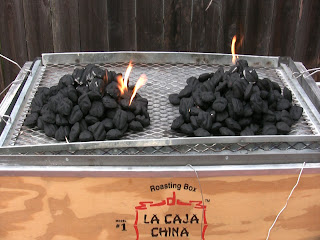Corned Beef on La Caja China
 Although
often shrouded in myth and legend, St. Patrick was a real guy and many
scholars have documented his life and his travels. Patrick committed
himself to converting Ireland to Christianity, a herculean task, leaving little time for anything else. Life in 4th Century Ireland must
have been rough, and after a tough day of dealing with Druids, Patrick
would certainly have craved something to eat and perhaps a refreshing
beverage.
Although
often shrouded in myth and legend, St. Patrick was a real guy and many
scholars have documented his life and his travels. Patrick committed
himself to converting Ireland to Christianity, a herculean task, leaving little time for anything else. Life in 4th Century Ireland must
have been rough, and after a tough day of dealing with Druids, Patrick
would certainly have craved something to eat and perhaps a refreshing
beverage.I am certain that he would be baffled by the way society celebrates his life today with the block parties full of loud and drunk people dressed in every imaginable shade of green. At times I am baffled by it. Yet, there are still wonderful tributes, parades, and dinners held in his honor every year where that gorgeous Irish trait of hospitality is showcased. I would like to think my house keeps his memory alive every year when I invite 150 of my closest friends over for an afternoon of food, spirits, and music.
I am not a fan of the traditional way of cooking corned beef, whether it be in the crock pot or in a pot of boiling water. Whenever given the opportunity, I will grill. The last three St. Patrick's Days, I used my two venerable Webers and the results were good. But this year, with the guest list growing, I decided to employ my new toy: La Caja China.
Since buying my La Caja China ten months ago, I have used it four times, twice for pork shoulders, once for a whole 70 pound pig, and last Thanksgiving for three turkeys. It is such an enjoyable way to cook and invariably I am joined by neighbors and friends to just stand around, imbibe a bit, and enjoy the succulent smells of slow cooked meat. If you have an internal probe thermometer, or an Igrill, cooking with La Caja China is almost fool proof.
There is not a lot of information out there about grilling corned beef, let alone slow roasting it in La Caja China, so I decided to try it on my own and take some pictures along the way.
Step One: The Corned Beefs
Generally, when you use your La Caja China, a large crowd is expected. I decided to buy 8 corned beef briskets. Try to keep them all about the same size and weight. I don't really look beyond what your neighborhood grocery store has stocked, and I certainly don't think one brand is superior to the other.
Step Two: The basting sauce
I like to mix a rich brown mustard with maple syrup, soy sauce, and red pepper flakes. For 8 corned beefs, I made a about a cup.
Step Three: The Soak
At 5:30 AM I removed the corned beefs and dried them with paper towels. You need to change the salty water, wipe down the ice chest, then refill it with warm water. Dump the corned beefs back in, and soak for another hour and a half for a total of three hours.
Step Four: Baste, sprinkle, probe, and cover
I then placed in my La Caja China four aluminum cooking tins, Since they are somewhat collapsible, you can bend them in a way that they all fit. After placing two corned beefs in each tin --- fat side up --- I basted the top and sides with the marinade. Next, I sprinkled the spice packets over the corned beefs.
I use an Igrill, but any external probe thermometer will work just fine. Sink the probe half way through the thickest part of the corned beef and run the cord outside of La Caja China. Next, cover the tins, loosely, with foil. Place the metal charcoal bed on top.
Step five: Time to cook
I have a model one La Caja China and that calls for 16 pounds of charcoal, evenly divided in
two piles. DO NOT use Matchlight, stick with Kingsford. Douse the piles with lighter fluid, and after the fire catches, wait about 20 to 30 minutes before spreading them evenly across the charcoal bed.
Remember, as La Caja China cooks, a layer of suffocating ash develops. It is very important after an hour and a half to shake the ash off, and add fresh new coals. With the box open, I took the opportunity to baste the sides of the corned beefs with the marinade. It looked and smelled tremendous!
After shaking off the ash and adding fresh coals the temperature made its way to 160 degrees. It took me two hours and 45 minutes to reach that goal. Once removed, the corned beef sat for about 15 minutes before slicing. Our intention was to make corned beef paninis, so we sliced as thin as possible.
I must say, the meat turned out amazing --- smoked and sweet.
8 corned beefs, coleslaw, fresh rye bread, several versions of potato salad, and lot of sweets fed about 170 people. We also went through 10 bottles of whiskey and a keg. Happy St. Patrick's Day!












Comments
Post a Comment